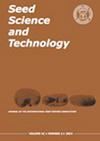Non-deep physiological dormancy in seeds of two endangered medicinal alpine species of Rhodiola from the Hengduan Mountains of southwest China
IF 3
4区 农林科学
Q2 AGRONOMY
引用次数: 0
Abstract
We investigated seed dormancy and germination characteristics of two endangered medicinal species, Rhodiola crenulata and R. fastigiata, from the high altitude (alpine) Hengduan Mountains in China. Germination of fresh seeds was tested in light and dark at six constant (1, 5, 10, 15, 20 and 25°C) and three alternating (5/1, 15/5 and 25/15°C) temperatures and again, after six months of dry after-ripening (DAR) and cold-wet stratification (CS). Fresh seeds of R. crenulata germinated to ≥ 80% at 10, 15, 25/15 and 15/5°C in light, but germination was significantly lower at 1, 5, 20 and 25°C. Germination of fresh seeds in dark was 0 to 25% across the range of temperatures. DAR and CS for six months increased germination and/or decreased mean germination time in both light and dark. Fresh seeds of R. fastigiata germinated to > 95% in both light and dark, except at 1°C in light and 1, 5, and 5/1°C in dark, where germination was < 50%. DAR and CS for six months increased germination and/or decreased mean germination time. Seeds of the two Rhodiola species have (conditional) non-deep physiological dormancy. Germination responses to temperature and light prevent seeds from germinating in the autumn of dispersal, but allow them to germinate quickly after snow melt the next spring. This study provides a method for obtaining plants from seeds of the two Rhodiola species for medicinal uses, which could reduce the harvesting pressure placed on natural populations.横断山两种濒危高山药用红景天种子的非深度生理休眠
研究了两种濒危药用植物红景天(Rhodiola crenulata)和红景天(R. fastigiata)的种子休眠和萌发特性。新鲜种子在6个恒定温度(1、5、10、15、20和25°C)和3个交替温度(5/1、15/5和25/15°C)的光照和黑暗条件下发芽,并在干燥后成熟(DAR)和冷湿分层(CS) 6个月后再次发芽。10、15、25/15和15/5°C光照条件下,小木犀的新鲜种子萌发率≥80%,但1、5、20和25°C光照条件下,小木犀种子萌发率显著降低。在黑暗中,新鲜种子在不同温度下的发芽率为0 ~ 25%。在光照和黑暗条件下,DAR和CS处理6个月提高了种子萌发率,降低了平均发芽时间。除光照条件下1°C、光照条件下1、5、5/1°C、黑暗条件下萌发率< 50%外,光照和黑暗条件下新鲜种子的萌发率均为95%以上。6个月的DAR和CS处理提高了种子萌发率和/或降低了平均发芽时间。两种红景天的种子具有(有条件的)非深度生理休眠。对温度和光照的发芽反应阻止种子在扩散的秋天发芽,但允许它们在第二年春天雪融化后迅速发芽。本研究提供了一种从两种红景天种子中提取药用植物的方法,可以减少对自然种群的收获压力。
本文章由计算机程序翻译,如有差异,请以英文原文为准。
求助全文
约1分钟内获得全文
求助全文
来源期刊

Seed Science and Technology
农林科学-农艺学
CiteScore
3.00
自引率
28.60%
发文量
36
审稿时长
>36 weeks
期刊介绍:
Seed Science and Technology (SST) is an international journal featuring original papers and articles on seed quality and physiology related to seed production, harvest, processing, sampling, storage, genetic conservation, habitat regeneration, distribution and testing. A journal that meets the needs of researchers, advisers and all those involved in the improvement and technical control of seed quality. Published every April, August and December.
 求助内容:
求助内容: 应助结果提醒方式:
应助结果提醒方式:


